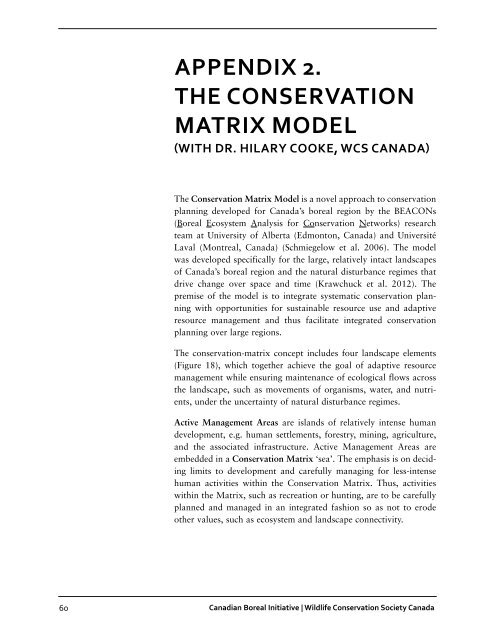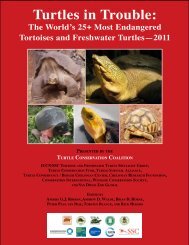Create successful ePaper yourself
Turn your PDF publications into a flip-book with our unique Google optimized e-Paper software.
Appendix 2.<br />
The Conservation<br />
Matrix Model<br />
(with Dr. Hilary Cooke, <strong>WCS</strong> <strong>Canada</strong>)<br />
The Conservation Matrix Model is a novel approach to conservation<br />
planning developed for <strong>Canada</strong>’s boreal region by the BEACONs<br />
(Boreal Ecosystem Analysis for Conservation Networks) research<br />
team at University of Alberta (Edmonton, <strong>Canada</strong>) and Université<br />
Laval (Montreal, <strong>Canada</strong>) (Schmiegelow et al. 2006). The model<br />
was developed specifically for the large, relatively intact landscapes<br />
of <strong>Canada</strong>’s boreal region and the natural disturbance regimes that<br />
drive change over space and time (Krawchuck et al. 2012). The<br />
premise of the model is to integrate systematic conservation planning<br />
with opportunities for sustainable resource use and adaptive<br />
resource management and thus facilitate integrated conservation<br />
planning over large regions.<br />
The conservation-matrix concept includes four landscape elements<br />
(Figure 18), which together achieve the goal of adaptive resource<br />
management while ensuring maintenance of ecological flows across<br />
the landscape, such as movements of organisms, water, and nutrients,<br />
under the uncertainty of natural disturbance regimes.<br />
Active Management Areas are islands of relatively intense human<br />
development, e.g. human settlements, forestry, mining, agriculture,<br />
and the associated infrastructure. Active Management Areas are<br />
embedded in a Conservation Matrix ‘sea’. The emphasis is on deciding<br />
limits to development and care<strong>full</strong>y managing for less-intense<br />
human activities within the Conservation Matrix. Thus, activities<br />
within the Matrix, such as recreation or hunting, are to be care<strong>full</strong>y<br />
planned and managed in an integrated fashion so as not to erode<br />
other values, such as ecosystem and landscape connectivity.<br />
60 Canadian Boreal Initiative | Wildlife Conservation Society <strong>Canada</strong>







![RaLand / SeaScape [PDF] - Wildlife Conservation Society](https://img.yumpu.com/49974326/1/190x245/raland-seascape-pdf-wildlife-conservation-society.jpg?quality=85)









